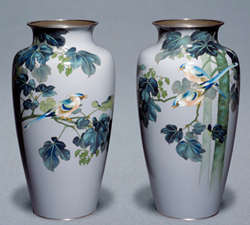
Japanese Enamels: The Seven Treasures
Lecture: Gregory Irvine, Senior Curator Asian Department of the Victoria & Albert Museum
15 August 2011, London

The combining of the V&A’s historical collection (including examples acquired at the Paris International Exposition of 1867, the earliest documented cloisonné enamels in any world collection) with the recent generous gift of Japanese enamels from Mr Edwin Davies, OBE, enables the V&A to present a rounded picture of one of Japan’s most exquisite art forms in an exhibition that will be held in the V&A’s Japan Gallery from 14 June 2011 – 19 August 2012.
The lecture will discuss enamels from
their early use as architectural fittings, through elegant inlaid metalwork of the late 17th century and into the Golden Age and the 20th century. It will explore objects from the renaissance of Japanese enamelling in the 1840s; the experimental works of the 1850s and 1860s and the rise of master artists such as Hayashi Kodenji, Namikawa Yasuyuki of Kyoto, Namikawa Sosuke of Tokyo and the output of the creative, innovative and prolific Ando Cloisonné Company of Nagoya.
Gregory Irvine is Senior Curator in the Asian Department of the Victoria & Albert Museum, London and is principally responsible for the collections of Japanese metalwork, focusing on arms, armour and cloisonné enamels. He has visited Japan on many occasions to carry out research at museums, temples, shrines and in private collections.
‘There are two distinct qualities or types expressed in Japanese art: one suggesting endless patience in the execution of minute detail, the other denoting a momentary conception of some fleeting idea carried out with boldness and freedom of expression in form and line – profuse complexity and extreme simplicity… the work on Japanese cloisonné ware generally exhibits the quality suggestive of unwearying labour and patience.’ (Harada Jiro, The Studio, 1911)
The characters used for Shippo, the Japanese term for enamels, are a reference to the Seven Treasures mentioned in Buddhist texts. The Japanese applied this term to the rich colours found on Chinese enamels and to those made later in Japan. The art of cloisonné enamelling was, from the late 1850s, one of Japan’s most successful forms of manufacture. The peak of artistic and technological sophistication was between 1880 and 1910, a period referred to as the ‘Golden Age’, and a time when the taste for Japan in the West was at its height and museums were avidly acquiring from dealers and international exhibitions.
Publications include Japanese Cloisonné: the Seven Treasures: V&A Publications, London, 2006; A Guide to Japanese Art Collections in the UK, Japan Society/Hotei, 2004; Collecting Japanese art at the Victoria and Albert Museum, Arts of Asia, Volume 39, Number 4, July – August 2009 and most recently Japanese Cloisonné Enamels, V&A Publications, London, 2011.
Admission Free but booking recommended
To reserve your place, please call the Japan Society office on 020 7828 6330 or email events@japansociety.org.uk
15 August 2011, 18:45pm |
 |
|
SOAS University of London, Khalili Lecture Theatre, Thornhaugh Street, Russell Square |
||
Tel: 020 7828 6330 |
||
The Japan Society |
||
